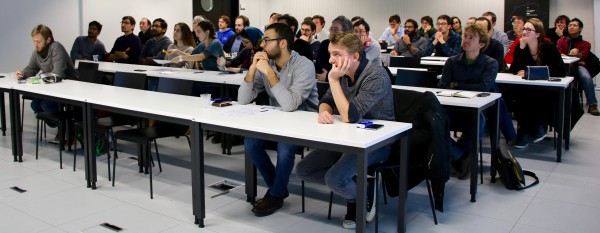MARVEL Junior Seminar — March 2017
The MARVEL Junior Seminars aim to intensify interactions between the MARVEL Junior scientists belonging to different research groups located at EPFL. The EPFL community interested in MARVEL research topics is very welcome to attend. We believe that these events will be central for establishing a vibrant community.
Each seminar consists of two presentations of 25 minutes each, allowing to present on a scientific question in depth, each presentation being followed by 10 minutes for discussion. The discussion is facilitated and timed by the chairperson of the day whose mission is to ensure active lively interactions between the audience and the speakers.
Pizza is served as of 11:45 in the MED hall (floor 0), and after the seminar at 13:30 you are cordially invited for coffee and dessert to continue discussion with the speakers.

MARVEL Junior Seminar Organizing Committee — Ariadni Boziki, Francesco Ambrosio, Fernando Gargiulo, Sandip De, Davide Tiana, Michele Pizzochero, Quang Van Nguyen and Nathalie Jongen
Check the list of the next MARVEL Junior Seminars in 2017 here.
Abstract — Redox levels through constant Fermi-level ab initio molecular dynamics - Assil Bouzid
Electrochemical processes such as electron/proton transfers take place in many important research areas such as solar cells, energy storage devices, biological environments, and many technological devices. The calculation of redox potentials is then important to understand and predict the electrochemistry of chemical reactions. Hence, several methods have been developed to study the thermodynamical and chemical properties of redox half reactions.1–4 In this talk, I will present our method to determine redox levels of half reactions through the use of ab initio molecular dynamics evolving at constant Fermi energy. This scheme models the effect of an electrode by controlling the charge transfer between the single-particle energy levels of the system and an electron reservoir set at a given potential during the dynamics. Like the thermodynamic integration method, our scheme does not require a priori knowledge of the products of the reaction, which can simply be obtained by driving the reaction through the variation of the Fermi level.
The simulations are performed subject to periodic boundary conditions, in absence of any counterelectrode. We use the rVV10 functional which is based on a semilocal generalized gradient approximation for the exchange-correlation energy and augmented to include van der Waals interactions.5 We extract the redox level from the evolution of the Kohn-Sham energies upon charging (or discharging) the system. Using Janak’s theorem and assuming a quadratic evolution of the Kohn-Sham energy of the highest occupied state upon charging, we demonstrate that our scheme for the determination of redox levels is equivalent to the thermodynamic integration method. The approach is illustrated for the redox couples Fe+2/Fe+3, HO•2/HO−2, and MnO−4/MnO−2 in aqueous solution, and yields redox potentials differing by less than 0.1 eV from respective ones achieved with the thermodynamic integration method. Based on these results, we conclude that the constant-Fermi-level technique is a promising tool to study redox reactions at electrode surfaces in nearly realistic conditions.
1 F. Ambrosio, G. Miceli, and A. Pasquarello, J. Chem. Phys. 143(24), 244508 (2015).
2 J. Cheng and J. VandeVondele, Phys. Rev. Lett. 116(8), 086402 (2016).
3 R. Jono, Y. Tateyama, and K. Yamashita, Phys. Chem. Chem. Phys. 17(40), 27103 (2015).
4 J. Cheng, X. Liu, J. VandeVondele, M. Sulpizi, and M. Sprik, Acc. Chem. Res. 47(12), 3522 (2014).
5 R. Sabatini, T. Gorni, and S. de Gironcoli, Phys. Rev. B 87(4), 041108 (2013).
Abstract — Grand-canonical first-principles simulations of electrochemical interfaces - Nicolas Hörmann
This presentation will describe our efforts in understanding the thermodynamic properties of electrochemical interfaces from first-principles calculations. Results will be presented using metal-water interfaces — Pt and Cu electrodes — as case studies, and with the solvent represented with a continuum model (self-consistent continuum solvation (SCCS) [1], as developed and implemented in the ENVIRON module of Quantum-ESPRESSO [2]). After a brief introduction to electrochemistry and to the relevant state variables, the differences between our approach and the widely used “computational hydrogen electrode”[3] will be discussed, both in principle and with some examples. In particular, we will show how our approach allows calculations at constant electrode potential (= constant Fermi level), to describe explicitly field-dependent properties. The results presented will focus on H and Cl adsorption, and it will be shown how the neglect or inclusion of field effects can lead to significantly different equilibrium structures and energetics.
[1] O. Andreussi et al., J. Chem. Phys. 136, 064102 (2012)
[2] P. Giannozzi et al., J. Phys. Condens. Matter 21, 395502 (2009)
[3] J. K. Norskov et al., J. Phys. Chem. B 108, 17886 (2004)
Low-volume newsletters, targeted to the scientific and industrial communities.
Subscribe to our newsletter